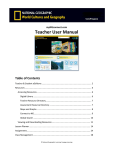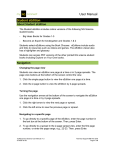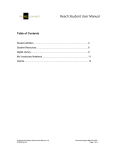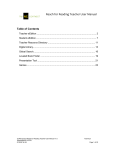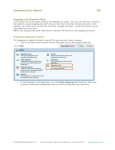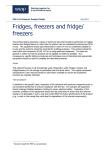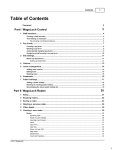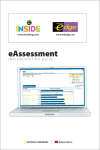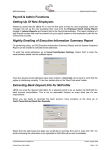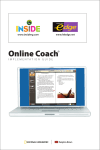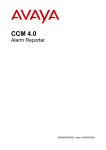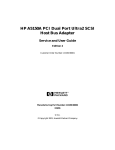Download Science User Manual – Table of Contents
Transcript
Science User Manual – Table of Contents Teacher eEdition ....................................................................................................................................... 2 Lesson Planner .......................................................................................................................................... 6 Student eEdition ..................................................................................................................................... 13 Teacher Resource Directory.................................................................................................................... 17 Student Resources .................................................................................................................................. 19 Digital Library .......................................................................................................................................... 20 Global Search .......................................................................................................................................... 23 Leveled Book Finder ................................................................................................................................ 27 Presentation Tool .................................................................................................................................... 29 Games ..................................................................................................................................................... 32 User Management .................................................................................................................................. 34 Rostering................................................................................................................................... 34 Class Management .................................................................................................................... 34 Preview ...................................................................................................................................... 36 User Manual Teacher eEdition About Teacher eEdition The Teacher’s eEdition is an electronic, online version of the Teacher textbook. Within the Teacher’s eEdition, users can interact with the myNGconnect content in several ways, such as navigating various units and books, zooming in and out on content, making and saving notes, and highlighting content they deem important. Notes Adding a note 1. To add a note, first click the Note icon at the top of the eEdition component. This will display a sticky note at the bottom right of the page. 2. Enter your text within the body of the note, and use the tools at the top as needed to format your note. Notes are saved automatically. Editing a note 1. To edit a note, first hover over a note with your mouse. 2. Then click anywhere inside the note. This will display the note in Edit mode. 3. Once in Edit mode, change the text as you would in any standard desktop publishing application. Your edits are saved automatically. Deleting a note 1. To delete a note, from Edit mode, click the Delete button in the lower right corner of the note. 2. This will prompt you to confirm your deletion. Click “Delete” in the confirm window to delete the note. Moving a note To move a note, click on the icon and drag it to the desired spot on the screen. myNGconnect Science User Manual v1.5 © NGSP & HB Technical Support 888-915-3276 Page 1 of 36 Viewing a note To view a note, hover over the note with your mouse. This will display the contents of the note. Highlights Adding a highlight 1. To add a highlight, first click the Highlight icon at the top of the eEdition component. This will enable the Highlight tool. Your cursor will become a plus sign (+). 2. Click and drag your cursor across the area of the page you wish to highlight. Deleting a highlight 1. To delete a highlight, hover over the highlighted area with your mouse. This will reveal a close button (x) in the upper right corner of the highlight. 2. Click the close button to delete the highlight. Navigation Changing the page view You can view your eEdition one page at a time or in 2-page spreads. Use the page view buttons at the top of the screen to change your view. 1. Click the single-page button to view the eEdition one page at a time. 2. Click the 2-page button to view the eEdition by 2-page spreads. Turning the page Use the navigation arrows at the bottom of the screen to navigate the eEdition one page at a time or by 2-page spreads. 1. Click the right arrow to view the next page or spread. 2. Click the left arrow to view the previous page or spread. 3. You may also click anywhere along the left side of the book display to turn to the previous page(s), or click anywhere along the right side of the book display to turn to the next page(s). myNGconnect Science User Manual v1.5 © NGSP & HB Technical Support 888-915-3276 Page 2 of 36 Returning to the previously viewed page To view the page you were on previously, click the Last Page button, which appears like a Back button at the bottom of the screen. Navigating to a specific page 1. To go directly to a specific page of the eEdition, enter the page number in the text box at the bottom of the screen. Then, press Enter on your keyboard. 2. To go directly to a spread in the 2-page spread view, enter the first page number of the spread, or enter the page range, e.g., 22-23. Then, press Enter on your keyboard. Navigating to a specific part of the book To navigate to a specific section or sub-section, use the Go To menu in the upper left corner of the screen. 1. First, click the Go To button to expand the menu. 2. Each section is expandable; use the arrow to expand and/or collapse the sections to locate the part you wish to view. 3. Click the subsection you wish to view, and it will be displayed on the screen. Zooming in and out You can expand or reduce your page view using the magnifying glass buttons at the bottom of the screen. Each time you click a magnifying glass, the view changes by 10%. 1. To zoom in, click the magnifying glass with the plus sign. You can expand your view up to 200%. 2. To zoom out, click the magnifying glass with the minus sign. You can reduce the view down to 70%. 3. You may also enter a percentage, between 70 and 200, in the box beside the Zoom tools at the top of the screen. Type the number and press the Enter key. myNGconnect Science User Manual v1.5 © NGSP & HB Technical Support 888-915-3276 Page 3 of 36 Changing books 1. To change books, first click the “Change Book” button which appears at the top left corner of the screen. 2. This will display the Teacher Book Chooser dialog window, which contains a scrolling list of available books, organized by strand. Click a book cover (from the Step 1 area) to view books within that level. 3. To select a book, click a thumbnail book under Step 2. This will display the selected book within the Student eEdition or Teacher eEdition or in a separate window with Adobe® Reader®, depending on your selection. Search Searching within the eEdition 1. To search within an eEdition, first click the Search button which appears as binoculars at the top right corner of the screen. 2. This will display a search box. In the text box at the top, enter a word or short phrase to search for. 3. Click the Search button. This performs a search on the entire book. Results are displayed below, listed by page number, with the searched word highlighted. Media Assets Playing an audio file Embedded materials, such as audio files, are indicated within Teacher eEdition by clickable “hotspots.” 1. To play an audio file, click the hotspot to launch the embedded file. 2. A pop-up player will display with a Play/Pause button. Click this button to play the audio. Adjusting audio volume Audio files appear within a pop-up player, which contain a volume control. 1. To adjust the volume, click and drag the control to the left (to decrease the volume) or right (to increase the volume). myNGconnect Science User Manual v1.5 © NGSP & HB Technical Support 888-915-3276 Page 4 of 36 2. You may also mute and un-mute the audio by clicking the speaker icon. Playing a video Embedded materials, such as video files, are indicated within Teacher eEdition by clickable “hotspots.” 1. To play a video file, click the hotspot to launch the embedded file. 2. A pop-up player will display, containing the video. You may either click the play button in the middle of the video, or the play button at the bottom of the pop-up, to start the video. 3. Click the pause button to stop the video at its current spot. Click play to restart the video. 4. Move the slider to jump to an earlier or later spot in the video. 5. Click the full-screen icon to expand the video to fill your screen. Click escape on your keyboard to close the full-screen view. 6. Click the close icon to close the video player. Viewing video captions The video player includes captions, which display below the video. 1. Click Captions On to see text captions below the video. 2. Click Captions Off to turn off the caption display. Adjusting video volume You can control volume using the controls in the video player. 1. Click the speaker icon to mute the volume. Click the speaker icon again to turn off mute. 2. To raise the volume, click and drag the volume bar to the right. 3. To lower the volume, click and drag the volume bar to the left. myNGconnect Science User Manual v1.5 © NGSP & HB Technical Support 888-915-3276 Page 5 of 36 User Manual Lesson Planner About the Lesson Planner The Lesson Planner allows you to schedule NG Science instruction in the way that best fits your calendar and teaching goals. The Lesson Planner organizes instruction into lessons or activities. All NG Science activities have been preloaded into the planner. You can start with a premade plan and move activities as needed. Or, you can start with a blank plan. You can also schedule events, create custom activities, add notes for any day, and print your plan. You can quickly access today's activities from the daily plan view on any myNGconnect screen. Today's activities with their associated online resources are also easily found in the Presentation Tool. Creating, Removing, and Navigating Lesson Plans Creating a new lesson plan The NG Science Lesson Planner offers a wide range of premade plans from which to choose. Each premade plan covers two weeks of instruction. After selecting a premade plan, you can easily move, add, or remove activities to suit your local needs. You can also start with a blank plan by selecting Build Your Own Plan. To set up a new plan, 3. Click the “Create New Lesson Plan” button in the Lesson Planner toolbar. The Create a New Lesson Plan dialog box will open. 4. For Step 1, enter a plan name and select a start date by clicking the calendar icon. It's a good idea to include the unit number in your plan name. 5. For Step 2, click the unit (kindergarten, grade 1, or grade 2) or strand (grades 3-5) you would like to cover. Click Continue to go to the next screen. 6. Step 3 offers the choice of beginning with a premade plan or building a plan from scratch. • Selecting the "build your own" option will take you to a blank plan screen where you can begin adding activities. myNGconnect Science User Manual v1.5 © NGSP & HB Technical Support 888-915-3276 Page 6 of 36 • Starting with a premade plan will take you Step 4 where you can choose from a standard or accelerated plan. Select a plan and click Save. Navigating lesson plans Each plan, which you set up, is listed in My Plans with the name you assigned. To navigate to a different plan, click the My Plans pull-down menu and select the plan you wish to view. Your plan will display in the main lesson planner screen by work week. Activities show in blocks for each day. A scrollbar may display for days with multiple activities. Total activity duration for the day displays in the weekday headers. You can select a different week within a specific plan by clicking the forward or back arrows next to the date on the left of the screen. Removing a lesson plan 1. Select Remove Plans from the Actions pull-down menu. This will open the Remove Lesson Plans window with of list of your plans. 2. Select one or more plans that you would like to remove from the list. 3. Click Remove at the bottom of the window. A confirmation pop-up will prompt you to confirm removal. Managing Events Events allow you to schedule non-teaching days for one or all of your plans. You can move activities forward by a day to accommodate an event, or remove them from your plan. Events display in blue on your plans. Scheduling an event 1. Select Manage Events from the Actions pull-down menu. This will display the My Events window. 2. Click the day in the calendar on which you would like to schedule an event. 3. Select a start date. If your event will last more than one day, select an end date. 4. Input your event's name. 5. Identify which plans should display the event, the current plan, all plans for the current class, or all plans for all of your classes. myNGconnect Science User Manual v1.5 © NGSP & HB Technical Support 888-915-3276 Page 7 of 36 6. Identify whether you would like all activities moved ahead a day to accommodate the event. You can also choose to remove the activities scheduled for the day of the event. 7. Click Save. You can either add another event or click Cancel to close the My Events window. Removing a scheduled event 1. Select Manage Events from the Actions pull-down menu. This will display the My Events window. 2. Click the day of the event, which you would like to reschedule, in the calendar. 3. Identify whether you would like all activities moved back a day or left as is. 4. Click Remove. You can either add another event or click Cancel to close the My Events window. Adding a Note You can a note to any day of your plan. The note icon in the day header goes from light to dark when you add a note. Notes include simple formatting tools such as bold, italics, numbered lists, and bulleted lists. You can also add a link to your note. To begin, find the day for which you would like to add a note in the weekly view of your plan. Then, 1. Click the Note icon in the day's header. 2. Click inside the text box and input your note. Formatting icons will display as soon as the text box is activated. Click one of these icons to activate the formatting tool. 3. Click the orange circle in the upper right of the note to save and close. myNGconnect Science User Manual v1.5 © NGSP & HB Technical Support 888-915-3276 Page 8 of 36 Managing Activities The lesson planner includes tools for adding, moving, and removing activities from any of your plans. Activities scheduled for days that have passed are locked. In the weekly view, you can open any activity detail window by clicking an activity name hyperlink. The activity detail window displays information such as Teacher's Edition page numbers, approximate duration, and associated online resources. It also includes functionality for rescheduling or removing the activity from your plan. Outside of the lesson plans, NG Science activities are organized in unit part folders. You can access these folders by selecting Manage Activities from the Actions pull-down menu. Viewing activity details You can view the detail window for any activity by clicking its name in the weekly view. The detail window includes descriptive information and linked resources if available. Standards are also available for some states. From the detail window, you can preview linked resources and print the activity information. Moving an activity within the week The drag and drop feature is the simplest way to move an activity to a different day in the same week. 1. Navigate to the weekly view of your plan. Put your mouse cursor over the activity, which you would like to move. 2. While your cursor displays an arrow, click and hold your left mouse button. Move your cursor to the desired location in the activity sequence for the target day. A black line will identify the activity's new position. 3. Release your mouse button. The screen will refresh with the activity in its new position. Moving an activity to another week 1. Click the activity name link to open the activity detail window from the weekly view of your plan. 2. Click the Change Date link at the top of the details window. This will display a calendar. 3. Click a new date in the calendar. Then, click the Save button. Click Yes in the confirmation pop-up to confirm the date change. myNGconnect Science User Manual v1.5 © NGSP & HB Technical Support 888-915-3276 Page 9 of 36 4. Removing an activity Clicking the red "x" at the top right corner of the activity block in the weekly view is the simplest way to remove it from your plan. You can also remove an activity via the activity detail window by clicking the Remove button, which displays with a red label. A third way to remove an activity is by way of Manage Activities under the Actions pull-down menu. This method involves locating the activity in a unit part folder. Once you find the activity, click the associated calendar and then click Remove. A pop-up will prompt you to confirm the activity removal with each of these methods. Adding an activity 1. Select Manage Activities from the Actions pull-down menu. This will display the Add/Remove Activities window. 2. Click the desired unit part folder to see a list of associated activities. 3. Once you locate the activity, click the date field or the calendar icon to open the calendar pop-up. 4. Select a date in the calendar pop-up. Then click the Save button. 5. When you are done adding activities, click the Save button in the Add/Remove Activities window. A confirmation window will display. 6. Review the list of activities that will be added or removed from your plan. Click OK to save the changes and return to your plan. Custom Activities The NG Science lesson planner includes activities for all instruction in the Teacher's Edition. You can block time for your own activity by creating a custom activity. Custom activity blocks display with a yellow sunburst and are saved in the Custom Activities folder. Like the preloaded activities, custom activities include space for a name, description, and duration. They can also be linked to an online resource. Creating a custom activity 1. Select Manage Activities from the Actions pull-down menu. This will display the Add/Remove Activities window. myNGconnect Science User Manual v1.5 © NGSP & HB Technical Support 888-915-3276 Page 10 of 36 2. Click the Create a Custom Activity button in the lower left. This will open the Create a Custom Activity window. 3. Fill in a name for the activity, select its duration, and the day on which you would like it to appear. You may also add a description but this is not required. 4. Click the Save to add the custom activity to your plan. This adds the new activity to the Lesson Planner and the “My Custom Activities” folder within the Activities list. Adding a resource to a custom activity Just as many preloaded NG Science activities include resources, you can link an online resource to your custom activity. If you would like to add an image or video clip, open the Digital Library. If you would like to add another resource such as a PDF or MP3, open Teacher Resource Directory. 1. Locate the resource you would like to add in the Digital Library or Teacher Resource Directory. 2. Click the resource record to open the resource detail window. 3. Click the blue Add to Planner button in the resource preview part of the window. A new window for specifying the target custom activity will display. 4. Select your plan from the Lesson Plan pull-down at the top right of the window. And select the date on which you scheduled the custom activity. 5. Select the custom activity from the Activity pull-down menu on the left of the window. 6. Click Save. From here you can either add another resource or click the Lesson Planner tab to return to your plan. Editing a custom activity You can edit the name, description, duration, and date of any custom activity. Click the activity name in the weekly view and from detail window, • Click Change Date to reschedule the custom activity. • Click Edit to change the description. • Select a new time from the pull-down menu to change the duration. • Click the red "x" next to a resource to remove it. Or, click Remove All to remove all resources linked to the custom activity. • Click Save to save your changes and return to the plan. myNGconnect Science User Manual v1.5 © NGSP & HB Technical Support 888-915-3276 Page 11 of 36 Printing a Plan The Lesson Planner's printing feature offers two views. Week at a Glance prints summary information for each week of your plan including total duration for each day, linked resources, and where available, standards. The detailed view includes detailed information for each scheduled activity. If you have Adobe Reader, you can use the print feature to save a copy of your plan as a PDF. 1. Select Print Plans from the Actions pull-down menu. This will display the Print Plan window. 2. Select a time period for your print-out. An end date is only needed if you wish to print more than one week of your plan. 3. Select the Week at a Glance or Detailed print format. 4. Click Print Preview. Then, click Print to activate your browser's print function. (If you wish to save a copy of the plan, select Adobe PDF instead of a printer.) Planner Daily View The Planner Daily View provides a quick look at the current day’s activities, and can be accessed from any component within myNGconnect. 1. Click the Planner Daily View button at the top right of any screen. The sliding panel will overlay on the existing window. 2. Select your plan from the Lesson Plan pull-down menu in the upper right of the panel. Then, select a date. 3. Scroll down as needed to view the activities. 4. To view activities scheduled for another day, click the calendar icon. Or, click the forward/back arrows next to the date to scroll through the current week by day. myNGconnect Science User Manual v1.5 © NGSP & HB Technical Support 888-915-3276 Page 12 of 36 User Manual Student eEdition About Student eEdition The Student eEdition includes online versions of the following NG Science student books: • Big Ideas Books for Grades 1-5 • Become an Expert for kindergarten and Grades 1 & 2 Students select eEditions using the Book Chooser. eEditions include audio and links to resources such as videos and games. The eEdition viewer also has a highlighter and glossary. Students can access PDF versions of the other printed NG science student books including Explore on Your Own books. Navigation Changing the page view Students can view an eEdition one page at a time or in 2-page spreads. The page view buttons at the bottom of the screen control the view. 1. Click the single-page button to view the eEdition one page at a time. 2. Click the 2-page button to view the eEdition by 2-page spreads. Turning the page Use the navigation arrows at the bottom of the screen to navigate the eEdition one page at a time or by 2-page spreads. 1. Click the right arrow to view the next page or spread. 2. Click the left arrow to view the previous page or spread. Navigating to a specific page 1. To go directly to a specific page of the eEdition, enter the page number in the text box at the bottom of the screen. Then, press Enter. 2. To go directly to a spread in the 2-page spread view, enter the first page number, or enter the page range, e.g., 22-23. Then, press Enter. myNGconnect Science User Manual v1.5 © NGSP & HB Technical Support 888-915-3276 Page 13 of 36 Zooming in and out Students can expand or reduce the page view using the magnifying glass buttons at the bottom of the screen. Each time students click a magnifying glass, the view changes by 25%. 1. To zoom in, click the magnifying glass with the plus sign. Students can expand the view up to 200%. 2. To zoom out, click the magnifying glass with the minus sign. Students can reduce the view down to 75%. Changing books Students can open a different online book with the Book Chooser, which is organized in two steps. In Step 1, the Book Chooser displays a carousel of Science book covers for each level. In Step 2, the Book Chooser displays the available student eEditions based on the Step 1 selection. eEditions open in the myNGconnect eEdition viewer. To change books from an open eEdition: 1. Click the Book Chooser icon, which appears in the top tool bar. This will open the Book Chooser window. 2. For Step 1, click the back or forward arrow on the carousel to find another Reach book cover within that level. The available books will display under Step 2. 3. For Step 2, click the cover of the book students want to view. Highlights Highlighting content 7. To highlight content within the eEdition, click the highlighter tool in the top tool bar. The cursor will become a plus sign (+). 8. Click and drag the cursor across the area of the page students wish to highlight. Release the cursor and the system will save the highlighting for future sessions. 9. To remove highlighting, hover the cursor over the highlighted area. Click the close button that displays in the upper right of the highlighter block. myNGconnect Science User Manual v1.5 © NGSP & HB Technical Support 888-915-3276 Page 14 of 36 Glossary The eEdition Glossary includes science vocabulary terms from the Big Ideas Books, arranged alphabetically. To use the Glossary: 1. Click the Glossary book icon located at the top right corner of the screen. The glossary will open in a pop-up window. 2. The alphabet is listed across the top of the window. Click the first letter of the word students want to find. Students will see a list of all the words starting with this letter on the left of the window. 3. Click the word in the word list. Students will see its definition on the right of the screen. 4. Students can look for another word or click the close icon in the upper right of the Glossary window. Playing Audio Read with Me audio allows students to listen to each page of K-2 eEditions and each chapter in the 3-5 eEditions. A blue speaker icon shows every opportunity to hear the main Read with Me text. Hotspots identify Read with Me audio for picture titles, labels, and captions. The cursor will change to a pointing hand when students roll it over a hotspot. To activate the audio: 1. Click a speaker icon to start the Read with Me audio for the main text, or click a picture hotspot to hear a title, caption, or label. 2. Click the speaker icon again to stop the main text audio. 3. Click the icon a third time to restart the Read with Me audio. Playing a Video Students can play unit launch videos and video clips within the eEdition by clicking the blue video camera icon. The video player will display in a pop-up window. 1. Click the play button to start viewing the video. 2. Click the pause button to stop the video at its current spot. Click play to restart the video. myNGconnect Science User Manual v1.5 © NGSP & HB Technical Support 888-915-3276 Page 15 of 36 3. Move the slider to jump to an earlier or later spot in the video. 4. Click the full-screen icon to expand the video to fill your screen. Click escape on the keyboard to close the full-screen view. 5. Click the close icon to close the video player. Viewing video captions The video player includes captions, which display below the video. 1. Click Captions On to see text captions below the video. 2. Click Captions Off to turn off the caption display. Adjusting video volume Students can control volume using the controls in the video player. 1. Click the speaker icon to mute the volume. Click the speaker icon again to turn off mute. 2. To raise the volume, click and drag the volume bar to the right. 3. To lower the volume, click and drag the volume bar to the left. Playing a Game or Enrichment Activity Games The pawn icon links students to a corresponding game set. This icon appears with science vocabulary in the Become an Expert books and with the 3-5 Big Ideas Book chapter openers. Enrichment Activities Students will find enrichment activity links on the covers of the kindergarten Become an Expert Books, tied to a big idea question in the 1-2 Big Ideas Books, and with chapter openers in the 3-5 Big Ideas Books. Click the blue plus icon to launch an enrichment activity. It will open in a new browser window. myNGconnect Science User Manual v1.5 © NGSP & HB Technical Support 888-915-3276 Page 16 of 36 User Manual Teacher Resource Directory About Teacher Resource Directory The Teacher Resource Directory enables teachers to browse both student and teacher-facing program resources, and provides teachers with a means to preview, download, and add media content to their Planners. Navigation Selecting a Program Part For Grades K-2: 10. To select a unit, click the drop-down menu at the top left to expand the unit selector, and then make an appropriate selection from the list. 11. This will display a left menu showing available resource groups for the selected unit. Choose a resource group from left menu. For Grades 3-5: 1. To select a strand, click the drop-down menu at the top left to expand the strand selector, and then make an appropriate selection from the list. 2. This will display a left menu with resource types and chapters for the chosen strand. Navigating the Left Menu The Resource Directory provides an expandable left menu of the resource group. Click a resource group from the left menu. Some menu items expand, showing further choices. After making your choice from the left menu, the associated resources will be displayed on the right side of the screen. 4. To view a resource, click anywhere in that resource’s row. myNGconnect Science User Manual v1.5 © NGSP & HB Technical Support 888-915-3276 Page 17 of 36 Resource Details Page The Resource Details page displays the details of your selected resource. Previewing an item 1. To preview an item, first navigate to select the appropriate resource. 2. Click the Preview button, located on the right side of the screen. This will open the item. Downloading an item You can download audio MP3, image, and PDF files from the Resource Directory. 1. To download an item, first navigate to select the appropriate resource. 2. Click the Download button, located on the right side of the screen. 3. This will open a new window where you can specify to Open or Save the file. If the resource is a PDF, the file will open in a new browser window. From the top browser menu, choose “File”, then “Save As…” Adding a resource to the Planner You can add a resource to any custom activity in your lesson plan. Custom activities display in the Daily Planner with a star icon. If a custom activity is not available on the day you’d like, open your planner and add one. 1. To add an item to the Planner, first navigate to select the appropriate resource (see the View Resource help information for instructions on Viewing a Resource). 2. Click the “Add to Planner” button, located on the right side of the screen. 3. This will display a new window; from here, choose the appropriate Lesson Plan from the drop-down menu in the upper right. 4. Select a day on the planner preview, at the right. Review the day for a target custom activity (with a star icon). 5. Select the target custom activity from the “Activity” drop-down menu, from the left side. 6. Click Save to add the resource to your custom activity. myNGconnect Science User Manual v1.5 © NGSP & HB Technical Support 888-915-3276 Page 18 of 36 User Manual Student Resources About Student Resources Student Resources give students online access to the NG Science MP3s. Students in kindergarten and grades 1 & 2 can also open the Big Idea Cards. Navigation To access Student Resources, click the Resources button on the student homepage. This opens the resource menu. Students follow three steps to navigate to the available resources from the menu. At each step, students can use the orange forward or back arrows to cycle through sets of options. The steps are: 12. Choose your unit. 13. Choose a resource type. For example, Big Ideas Book Read with Me MP3s 14. Choose a resource. MP3s open in a player. PDFs open in a new browser window. Students can download MP3s to their desktop by clicking the Save link. myNGconnect Science User Manual v1.5 © NGSP & HB Technical Support 888-915-3276 Page 19 of 36 User Manual Digital Library About Digital Library The Digital Library enables users to easily search & browse images and videos, and provides teachers with a means to add media resources to their Lesson Planner activities. Search Performing a Simple Search The initial view of Digital Library contains a Simple Search function for locating videos or images. 15. To search, enter your term(s) in the Search field and click the Search button. 16. This will display your Search Results. 17. From this screen, you may view details of the resulting videos/images, or refine your search using the Filter drop-downs on the left. 18. Click the small thumbnail image to see the details for the resource. Browse Browsing by categories The initial view of Digital Library contains a Browse Categories function for locating videos or images. 1. To browse the Digital Library categories, click either the Reach or Science tab. 2. Choose from the left menu. 3. On the right side select an appropriate category. 4. The videos/images will display from the categories you selected. From this screen, you may view details of the resulting videos/images, or refine your search using the drop-downs on the left. 5. Click the small thumbnail image to see the details for the resource. myNGconnect Science User Manual v1.5 © NGSP & HB Technical Support 888-915-3276 Page 20 of 36 Resource Details Page Previewing Details 1. To preview the Details of Digital Library videos/images, first locate the videos/images using the Search or Browse Category function. 2. Hover over the item with your mouse; this will display the Details, such as unit and description, for the item. Viewing a resource 1. To view a resource from Digital Library, click the thumbnail image from the search results screen. This will display all the item’s Details, as well as the video/image itself. Adding a resource to the Planner You can add a resource to any custom activity in your lesson plan. Custom activities display in the Daily Planner with a star icon. If a custom activity is not available on the day you’d like, open your planner and add one. 7. To add an item to the Planner, first navigate to select the appropriate resource (see the View Resource help information for instructions on Viewing a Resource). 8. Click the “Add to Planner” button, located on the right side of the screen. 9. This will display a new window; from here, choose the appropriate Lesson Plan from the drop-down menu in the upper right. 10. Select a day on the planner preview, at the right. Review the day for a target custom activity (with a star icon). 11. Select the target custom activity from the “Activity” drop-down menu, from the left side. 12. Click Save to add the resource to your custom activity. myNGconnect Science User Manual v1.5 © NGSP & HB Technical Support 888-915-3276 Page 21 of 36 Previewing an image 1. To preview an image, after locating the image through Search or Browse Category, click the small thumbnail image to view the item. 2. This will display the Details of the image, along with the image/video displayed in the top right corner of the screen. Click the Preview button, located above the image, to launch the image in a larger viewer. Downloading an image 1. To download an image, after locating the image through Search or Browse Category, click the thumbnail image to view the item. 2. This will display the Details of the image, along with the image displayed in the top right corner of the screen. Click the Download button, located above the image, to download the file. 3. This will open the image in a new window, right-click the image and choose “Save image as…” from the menu. Filter Filtering To filter resources, first perform a simple search or browse by categories to display the thumbnails of your search result. 1. Filtering by Resource Type: From the drop-down menu choose either Video Clip or Image, then click Go. 2. Filtering by Program: From the drop-down menu choose either Science or Reach. For some resources you can then perform further filtering. Click Go to perform the filtering. myNGconnect Science User Manual v1.5 © NGSP & HB Technical Support 888-915-3276 Page 22 of 36 User Manual Global Search About Global Search The Global Search allows users to search for learning resources in the system using keywords, resource types, or standards. Users may preview the various resources and/or add them to their Planner. Search Performing a Simple Search Once the Global Search component is active, you can use the Simple Search function to search using text entries and, if desired, filter the results using the Resource Type selector. Using the entry fields, you can search for all words, an exact wording or phrase, or for one or more words; you can also exclude words from your search. 19. To use Simple Search, first click to select the Simple Search option at the top of the screen. 20. Enter your relevant search terms in the text boxes. 21. Click the Resource Type drop-down and then click to select the appropriate resource type from the list, or leave it set to “All Resource Types.” 22. Click the Search button; this will display the results of your search within a table. If there is more than one page of results, navigate forward and back using the arrows at the top right. At the top of the results, you will see a box titled "Your Search Criteria." This box shows values on which your search is based. 23. From the results page, you can click one of the resource rows to preview it or click "Back to Search" to return to the search dialog. NOTE: Some of the search results may be grayed out; when you hover over these results with your mouse, you will see a "Subscription Required" note. This means your class (or district) has not subscribed to the corresponding unit. myNGconnect Science User Manual v1.5 © NGSP & HB Technical Support 888-915-3276 Page 23 of 36 Searching by standards Using the Standards Search tool within Global Search, you can search for resources that are correlated to a standard. 1. First, click to select the Standards Search option at the top of the screen. 2. Select the Grade associated with your standard(s) by clicking the Grade drop-down and then clicking the appropriate level from the list, or leave the list set to All to find standards in all grades. 3. Select the appropriate standard unit by clicking the Standard Strand dropdown and then clicking the appropriate standard from the list, or leave the list set to All to find standards in all units. 4. If you wish to add keywords that pertain to your search, enter them in the “Keywords:” text box. 5. Click the “Find Standards” button to display the resulting standards. 6. From the results page, you can click one of the resource rows to preview it or click "Back to Search" to return to the search dialog. NOTE: Some of the search results may be grayed out; when you hover over these results with your mouse, you will see a "Subscription Required" note. This means your class (or district) has not subscribed to the corresponding unit. myNGconnect Science User Manual v1.5 © NGSP & HB Technical Support 888-915-3276 Page 24 of 36 Resource Details Page Sorting results Initial search results are sorted by relevancy, with the best matches listed first. You can re-sort the results by any column heading. Click the Sort drop-down arrow, then choose how you would like the results sorted. Results will then display sorted by the heading you selected. Hovering over a row for details Global Search results display in a table, detailing each resource’s type, title, Strand, unit, grade, and user. If the information returned contains too many characters to display within the table, “more” will be displayed to indicate that more information is available. Viewing additional resource details Global Search results display in a table, detailing each resource’s type, title, strand, unit, grade, and user. If you wish to view additional details about the resource, such as a description, caption, category, or strand connection information, click the resource row. Previewing an item You can preview image, video, SWF, or PDF-based files within the Global Search. 1. To preview an item, first navigate to select the appropriate resource. 2. Click the Preview button, located on the right side of the screen. This will open the item. 3. Viewing a resource’s Book Connection Using the drop-down menu, select the correct program, the table will display the student book for which the resource is aligned. Downloading an item You can download audio MP3, image, and PDF files from Global Search. myNGconnect Science User Manual v1.5 © NGSP & HB Technical Support 888-915-3276 Page 25 of 36 1. To download an item, first navigate to the resource’s detail page. 2. Click the Download button, located on the right side of the screen. 3. This will open a new window where you can specify to Open or Save the file. If the resource is a PDF, the file will open in a new browser window. From the top browser menu, choose “File”, then “Save As…” Adding a resource to the Planner You can add a resource to any custom activity in your lesson plan. Custom activities display in the Daily Planner with a star icon. If a custom activity is not available on the day you’d like, open your planner and add one. 13. To add an item to the Planner, first navigate to select the appropriate resource (see the View Resource help information for instructions on Viewing a Resource). 14. Click the “Add to Planner” button, located on the right side of the screen. 15. This will display a new window; from here, choose the appropriate Lesson Plan from the drop-down menu in the upper right. 16. Select a day on the planner preview, at the right. Review the day for a target custom activity (with a star icon). 17. Select the target custom activity from the “Activity” drop-down menu, from the left side. 18. Click Save to add the resource to your custom activity. myNGconnect Science User Manual v1.5 © NGSP & HB Technical Support 888-915-3276 Page 26 of 36 User Manual Leveled Book Finder About Leveled Book Finder The Leveled Book Finder allows users to search leveled books by grade, topic, and their leveling system of choice. Once a search is performed, users can download an Excel file of the results. Search Performing a search Click the Leveled Book Finder link to launch the application in a new browser window. 24. Choose the grade level(s) you would like to search. 25. Choose the topics you would like to search. 26. In the Reach program, you can choose to include leveled books from other programs that your school may have access to. 27. Choose your desired leveling system. Search Results Viewing results Search results are grouped by topic. Depending on how many results are returned, you can page through the listing using the numbered boxes above the search results table. Downloading a Lesson Plan Some books have PDF lesson plans associated with them, which are noted by a PDF icon in the “Lesson Plan” column. Click the icon to open the file, which can be saved to your desktop. Save results Click the “Save Results” button to download an Excel file that contains the results of your search. myNGconnect Science User Manual v1.5 © NGSP & HB Technical Support 888-915-3276 Page 27 of 36 Performing a new search To perform a new search, click the “Search Again” button to enter your new search criteria. myNGconnect Science User Manual v1.5 © NGSP & HB Technical Support 888-915-3276 Page 28 of 36 User Manual Presentation Tool Daily Resources Opening a resource from Daily Resources Daily Resources provides a quick view and access to the student resources associated with the current day’s activities from the Lesson Planner. It is organized by the activity schedule and is used for presenting to the class the scheduled resources, such as audio, video, images, PDFs, and activities. Upon opening the Presentation Tool, Daily Resources will be displayed by default. 28. Using the My Plans drop-down menu, choose the appropriate Lesson Plan. By default the current day appears. To choose another day, click the calendar icon. 29. The list of activities and associated student resources will be displayed. 30. To open a resource, click to select it. It will then be displayed. 31. If you have closed Daily Resources and navigated to another area, click the “Daily Resources” button at the top of the screen to view the list of activities and associated student resources, then click the resource you wish to view. Unit Launch Videos Selecting Unit Launch Videos To select a Unit Launch Video, click the “Unit Launch Videos” button at the top of the screen to view the list of available videos. 1. Click to select the video you wish to view. It will open in full-screen mode; you may either click the Play button in the middle of the screen, or the Play button just below it, to start the video. Navigation Looking at a specific day’s resources Within Presentation Tool, the current day’s resources are displayed by default. 1. To view resources for another day, first click the calendar icon at the top of the screen. myNGconnect Science User Manual v1.5 © NGSP & HB Technical Support 888-915-3276 Page 29 of 36 2. This will display a calendar; simply click to select a date within the calendar. The Daily Resources panel will display, populated with the resources for the date that you selected. Opening resource panels You can navigate to various resources within Presentation Tool by using the resource panels, accessed through the buttons at the top of the screen. When you click a button, the sliding panel expands to show available resources. Click a resource to open it in full-screen presentation mode. The panel will automatically close once you select the resource. Opening an eEdition book 1. To open an eEdition book from within Presentation Tool, click the Student eEdition button at the top of the screen. 2. This will display the Book Chooser window, which contains a scrolling list of available books. Click the appropriate book from the Step 1 area at the top. 3. To display the book, click a thumbnail book under Step 2. This will display the selected book within the Presentation Tool. Clearing the screen If you wish to clear the Presentation Tool screen, click the “Clear Screen” button, located in the top right corner of the screen. This will close any open resources and panels, so that the only items remaining are the top navigational buttons. Exiting the Presentation Tool To exit the Presentation Tool, click the “Close Tool” button, located in the top right corner of the screen. This will display a confirmation message. Click Continue to close the Presentation Tool and return to the Teacher Home Page. myNGconnect Science User Manual v1.5 © NGSP & HB Technical Support 888-915-3276 Page 30 of 36 Playing a video Within Presentation Tool, you can access videos from the Daily Resources drop-down, Unit Launch Videos drop-down, or inside the Student eEdition. Turning on video captions Video files display within a pop-up player. Subtitle captions appear directly below the video. For information on turning on the captions, see the Teacher eEdition Media Assets help. Adjusting video volume Video files appear within a pop-up window, which contains a volume control underneath the video. For information on adjusting the volume, see the Teacher eEdition Media Assets help. Viewing an image Within Presentation Tool, you can access images from the Daily Resources drop-down. Downloading an image 1. To download an image, after clicking to view the image in its original size, click the Download button, located below the image. 2. This will open a new window where you can specify to Open or Save the file. myNGconnect Science User Manual v1.5 © NGSP & HB Technical Support 888-915-3276 Page 31 of 36 User Manual About Games Games are available online that provide a learning experience focusing on specific science vocabulary. Accessing Games Games can be launched 4 different ways: 1. 2. 3. 4. From the Student homepage From the Student eEditions From the Teacher eEdition From the Teacher Resource Directory Navigation From the Student homepage For grades K-2: • • • Choose Games from the Student homepage Choose a unit A games menu will launch in a separate window, choose a game and play For grades 3-5: • • • • Choose Games from the Student homepage Choose a strand Choose a chapter A games menu will launch in a separate window, choose a game and play From the Student eEdition For grades K-2: • • Click the Games link located in the Become an Expert Student eEditions. A games menu will launch in a separate window, choose a game and play myNGconnect Science User Manual v1.5 © NGSP & HB Technical Support 888-915-3276 Page 32 of 36 For grades 3-5: • • Click the Games link located in each chapter of the Student eEditions. A games menu will launch in a separate window, choose a game and play. From the Teacher eEdition • • Click the Games hotspots located in the Teacher eEdition A games menu will launch in a separate window, choose a game and play From the Teacher Resource Directory For grades K-2: • • • • • • Choose Resource Directory on the Teacher Homepage Choose a unit from the drop-down menu Choose Vocabulary Games from the left side menu Click Game on the right side Resource List Choose Preview from the right corner of the Resource Details to preview a game. Choose Add to Planner from the right corner of the Resource Details to add a game to the Online Lesson Planner. For grades 3-5: • • • • • • • Choose Resource Directory on the Teacher Homepage Choose a strand from the drop-down menu Choose a chapter from the left-side menu Choose Vocabulary Games Click Game from the right side Resource List Choose Preview from the right corner of the Resource Details to preview a game. Choose Add to Planner from the right corner of the Resource Details to add a game to the Online Lesson Planner. myNGconnect Science User Manual v1.5 © NGSP & HB Technical Support 888-915-3276 Page 33 of 36 User Manual User Management Rostering About Rostering Rostering is the process of placing students into each Teacher's class for myNGconnect, and assigning corresponding usernames and passwords. Each class is also set up with the appropriate grade and/or strand subscriptions and created in the correct district and school. When an order is placed, an NGSP support representative initiates Rostering by contacting the district's "Subscriber Contact" (stated on the "eProducts Supplemental Order Form" which is part of the purchasing paperwork). If the district's "Subscriber Contact" has not been in contact with an NGSP support representative, then they should call NGSP Tech Support at1-888-915-3276. Class Management Student Tab - Viewing Class Details When entering Class Management, the Detail information for the current class appears by default as the “Students” tab. For information on viewing Details for another class, see the Changing Classes help section. Changing classes 3. To change classes, click the class drop-down at the top right corner of the screen. 4. This will display a list of your classes, if you have more than one class. Clicking a class from the drop-down will display the details screen for that class. Viewing Student Details 1. To view Student Details, first, view the Class Details for that student’s class. 2. Click the “View details” link alongside the appropriate student. myNGconnect Science User Manual v1.5 © NGSP & HB Technical Support 888-915-3276 Page 34 of 36 3. This will display the Student Details page, listing the selected student’s name, class/school/district information, birthday/gender, login information, and subscriptions. Printing Student Details 1. To print a student’s details, first view the Details page for that student. 2. Click the Print link or icon, located in the top right corner of the screen. 3. This will display a new window, containing a printer-friendly version of the selected student’s Details page. Click the Print button at the top to print the student’s Details. Changing a student’s password 1. To change a student’s password, first, view the Details page for that student. 2. Then, click the “Change Password” link, located in the Login Information area. 3. This will display the Change Password window; simply click the new pictures for the student’s password, and then click the Save button. The pictures you selected will become the student’s new password. Printing a student’s username/password 1. To print an individual student’s password, first, view the Details page for that student. 2. Click the “Print Password” link, located in the Login Information area. 3. This will display a new window, containing a printer-friendly version of the selected student’s password. Click the Print button at the top to print the password. NOTE: You can also print a single student’s username/password by following the same steps as for printing multiple students’ usernames/passwords, and selecting a single student. myNGconnect Science User Manual v1.5 © NGSP & HB Technical Support 888-915-3276 Page 35 of 36 Printing multiple students’ usernames/passwords 1. In Class Details, select the students whose passwords you wish to print using the checkboxes beside their names. 2. When you’ve selected all the appropriate students, press the “Print Selected Passwords” button. 3. This will display a new window containing a printer-friendly version of the selected students’ passwords. Click the Print button at the top of the window. 4. After you’ve printed the printer-friendly password page, close the popup window. Preview Classes Preview Classes Tab - Viewing Preview Classes A Preview Class can be setup by clicking the link “Register a free preview account!” on the Educator Sign-in page, and entering the Key-Code located in the front of the Teacher’s Edition. A Preview Class can be created for each individual Teacher’s Edition, and allows an educator to preview the online content and do planning. NOTE: A preview class will only be available for 30 days from the day that a teacher creates it, then it expires. When the “Preview Classes” Tab is selected, the table shows which preview classes have been set-up for the educator currently signed in. Creating a Preview Class 1. Click the “Create Preview Class” button in the upper right corner of the table. 2. Follow the on screen instructions to enter the Key-Code found in the front of the Teacher’s Edition. myNGconnect Science User Manual v1.5 © NGSP & HB Technical Support 888-915-3276 Page 36 of 36





































